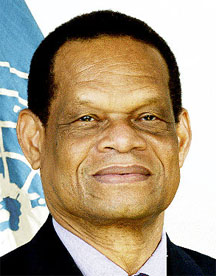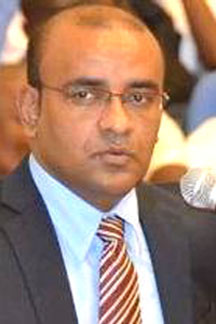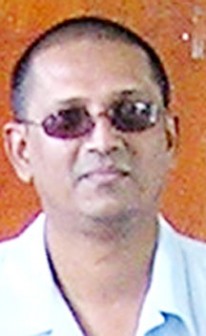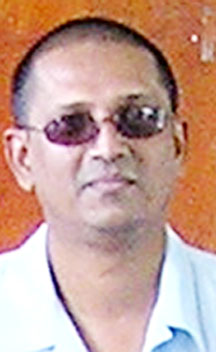Asks Donald Duff
Given all that transpired in the administration of cricket in Guyana over the past year one might have been tempted to view the intervention of the His Excellency, President Bharrat Jagdeo, as a blessing in disguise. Allegations of financial impropriety; the dousing of a cricket official with acid which that official claims was cricket related; the two separate elections of the Demerara Cricket Board which led to two factions both claiming to be the legitimate representatives for cricket in Demerara, culminating with the controversial Annual General Meeting of the Guyana Cricket Board, are just some of the issues that has affected cricket this year.
With the legitimacy of the AGM in question, the secretary of the Berbice Cricket Board (BCB) sought to have the Court intervene only to have the matter thrown out.
The Court’s decision left Cricket in Guyana at the crossroads.
 It was here that one felt that apart from Divine intervention, the only other possible solution to the crisis was the intervention of the government or more specifically the Ministry of Sport.
It was here that one felt that apart from Divine intervention, the only other possible solution to the crisis was the intervention of the government or more specifically the Ministry of Sport.
While political intervention in sport is not something that is readily applauded, given the state of Guyana’s cricket, one felt that the unreasonable behaviour of those seeking power (not office) had to be addressed.
The subsequent decision by the Court that it was not the proper authority to deal with the issue(s) meant that only two options remained.
The first was that parent body, the West Indies Cricket Board (WICB), would have intervened.

The second was, as recommended by acting Chief Justice Ian Chang, government intervention.
Political intervention in sport associations is frowned upon by a number of international federations especially FIFA and recently the International Cricket Council (ICC). Earlier this year, in June to be precise, the ICC told members not to allow government interference or face sanctions.
Therefore, the government’s decision to try and bring some measure of normalcy to the affairs of Guyana’s cricket was like batting on thin ice.
What, however, is of concern now, is the fact that there are more questions than answers since the decision to form the Interim Management Committee.
In fact, the new executive of the GCB headed by Ramsey Ali is not budging from its position that the present members of the GCB are legally, the anointed administrators of Guyana’s cricket.

This position is supported by the parent body the West Indies Cricket Board (WICB) which has stated on more than one occasion (and as recently as Friday when their Corporate Communications Officer Imran Khan gave the Ramsey Ali-led administration a vote of confidence) that it is the GCB and not the proposed IMC that they will work with. So where does that leave the status quo. It means that there is, according to the WICB, a legally elected GCB which certainly does not leave any room for an IMC.
Following a meeting between President Jagdeo and WICB president Julian Hunte, who flew to Guyana to discuss the issue of Jagdeo’s intervention, one would have thought that a definitive position on the way forward would have been stated.
Instead there was a general passing of the buck with the WICB saying that they had left it up to the government to issue an official response and the government saying that the WICB should do so.

This has led to what is virtually an unsatisfactory situation where there are two parallel entities tasked with performing one set of functions.
What the government probably should have done was to dissolve the GCB which would have allowed for the IMC to be used to regularise the affairs of the GCB but a fear of the repercussions legally and otherwise from the WICB and the ICC probably stayed the government’s hand.As usual it has been the cricketers who have been most affected with the Berbice players not be showing up to participate in trial matches mainly because of the political interference.
But Guyana is not alone on the issue of government interference in sport. In India there is a protest against sweeping government reforms which are intended to make the country’s sports federations more transparent.
The protest has received the backing of the Indian Cricket Board (BCCI) and the Indian Olympic Association (IOA). The Indian government has passed a bill known as the National Sports Development Bill, which “seeks to limit the tenure of all sports administrators and bring the federations under the scope of the country’s Right to Information (RTI) act,” the Reuters News Agency recently reported.
The move by the Indian government has also not found favour with the IOA.
“While we are happy with the accountability factor, we are not really happy with the interference of the government in sports bodies,” BCCI chief administrative officer Ratnakar Shetty told reporters in Mumbai.
Back in Guyana, the GCB and the WICB, seem to be going ahead with plans for the staging of the regional one day tournament which will be held here next month.
It has been reported that an unnamed Director of the WICB, has stated that any interference by the government in the affairs of Guyana’s cricket, could lead to the tournament being moved from Guyana to Barbados although to be fair the WICB has not given an official release confirming that decision.
All of this makes for interesting times ahead and given the lack of official news reports on the situation, lots of speculation.
Given the secrecy surrounding the meeting with President Jagdeo and Hunte, and the lack of information with respect to the formation of the IMC and its terms of reference, it seems pellucidly clear that cricket in Guyana is continuing along the path to nowhere.
Given the constant battles between the WICB and the West Indies Players Association (WIPA) and a new battle emerging between the Trinidad and Tobago Minister of Sports Anil Roberts and the Trinidad and Tobago Cricket Board president Azim Bassarath, cricket in the region seems destined for more turbulent times.

